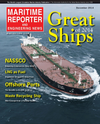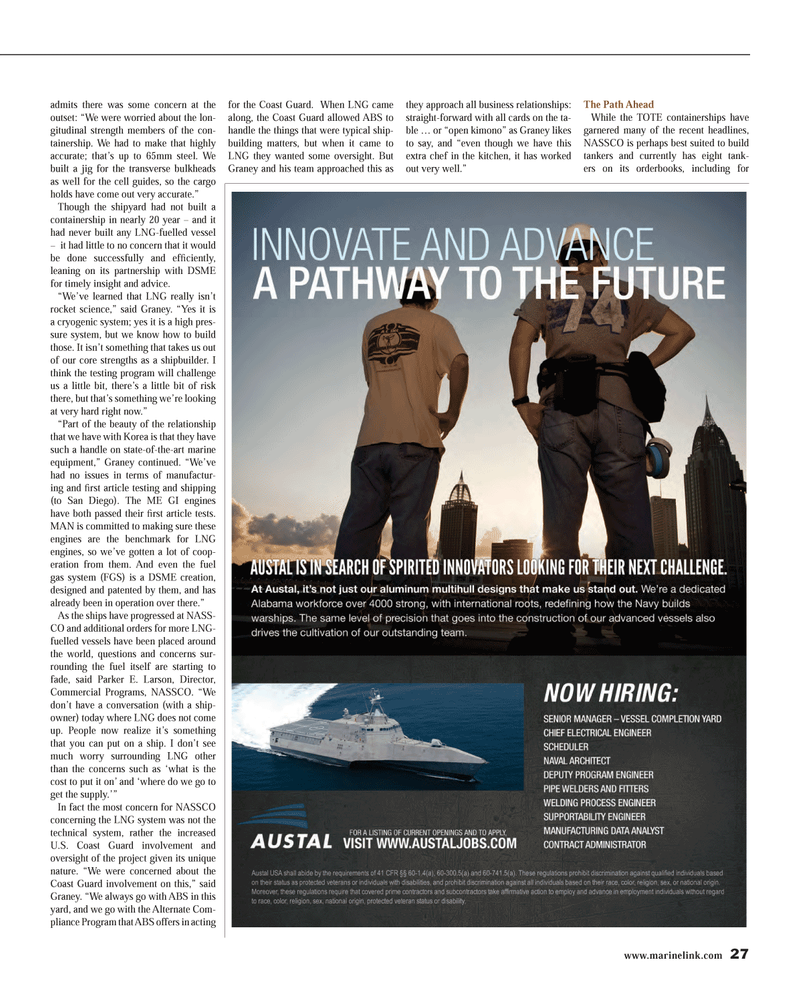
Page 27: of Maritime Reporter Magazine (December 2014)
Great Ships of 2014
Read this page in Pdf, Flash or Html5 edition of December 2014 Maritime Reporter Magazine
www.marinelink.com 27 admits there was some concern at the outset: “We were worried about the lon- gitudinal strength members of the con- tainership. We had to make that highly accurate; that’s up to 65mm steel. We built a jig for the transverse bulkheads as well for the cell guides, so the cargo holds have come out very accurate.”
Though the shipyard had not built a containership in nearly 20 year – and it had never built any LNG-fuelled vessel – it had little to no concern that it would be done successfully and effi ciently, leaning on its partnership with DSME for timely insight and advice. “We’ve learned that LNG really isn’t rocket science,” said Graney. “Yes it is a cryogenic system; yes it is a high pres- sure system, but we know how to build those. It isn’t something that takes us out of our core strengths as a shipbuilder. I think the testing program will challenge us a little bit, there’s a little bit of risk there, but that’s something we’re looking at very hard right now.” “Part of the beauty of the relationship that we have with Korea is that they have such a handle on state-of-the-art marine equipment,” Graney continued. “We’ve had no issues in terms of manufactur- ing and fi rst article testing and shipping (to San Diego). The ME GI engines have both passed their fi rst article tests.
MAN is committed to making sure these engines are the benchmark for LNG engines, so we’ve gotten a lot of coop- eration from them. And even the fuel gas system (FGS) is a DSME creation, designed and patented by them, and has already been in operation over there.”
As the ships have progressed at NASS-
CO and additional orders for more LNG- fuelled vessels have been placed around the world, questions and concerns sur- rounding the fuel itself are starting to fade, said Parker E. Larson, Director,
Commercial Programs, NASSCO. “We don’t have a conversation (with a ship- owner) today where LNG does not come up. People now realize it’s something that you can put on a ship. I don’t see much worry surrounding LNG other than the concerns such as ‘what is the cost to put it on’ and ‘where do we go to get the supply.’”
In fact the most concern for NASSCO concerning the LNG system was not the technical system, rather the increased
U.S. Coast Guard involvement and oversight of the project given its unique nature. “We were concerned about the
Coast Guard involvement on this,” said
Graney. “We always go with ABS in this yard, and we go with the Alternate Com- pliance Program that ABS offers in acting for the Coast Guard. When LNG came along, the Coast Guard allowed ABS to handle the things that were typical ship- building matters, but when it came to
LNG they wanted some oversight. But
Graney and his team approached this as they approach all business relationships: straight-forward with all cards on the ta- ble … or “open kimono” as Graney likes to say, and “even though we have this extra chef in the kitchen, it has worked out very well.”
The Path Ahead
While the TOTE containerships have garnered many of the recent headlines,
NASSCO is perhaps best suited to build tankers and currently has eight tank- ers on its orderbooks, including for
MR #12 (26-31).indd 27 12/5/2014 4:02:51 PM

 26
26

 28
28
